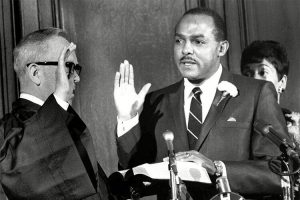
Cleveland Mayor Carl Stokes- Britanica
Mayoral quiz: On the eve of electing a new Cleveland mayor, test you knowledge on our past mayors
by Grant Segall, Freshwater Cleveland
www.teachingcleveland.org

Cleveland Mayor Carl Stokes- Britanica
Mayoral quiz: On the eve of electing a new Cleveland mayor, test you knowledge on our past mayors
by Grant Segall, Freshwater Cleveland
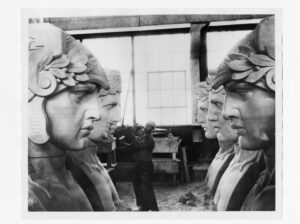
Summary of “Bail Reform” forum held at Cleveland Hts/University Hts Public Library on Thursday December 12, 2019
Experts say state needs bail reform
By JULIE HULLETT
The pdf is here
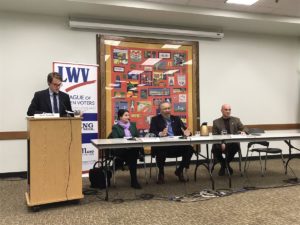
left to right: Nick Castele- Ideastream, Claire Chevrier ACLU Ohio, Judge Charles L. Patton Jr., Cleveland Municipal Court, Judge John J. Russo, Cuyahoga County Common Pleas Court
CLEVELAND HEIGHTS — Panelists at a Thursday forum concluded that the state of Ohio is in desperate need of bail reform, a slow yet necessary process to even the scales as defendants stand before the justice system.
The Greater Cleveland Chapter of the League of Women Voters sponsored the event at the Cleveland Heights-University Heights Public Library on Dec. 12, in addition to other sponsors such as Case Western Reserve University Siegal Lifelong Learning, Heights Public Library, Ideastream and First Interstate Properties, Ltd.
Nick Castele of WCPN/Ideastream moderated the panel, which consisted of advocacy counsel for the American Civil Liberties Union of Ohio Claire Chevrier, Cleveland Municipal Court Judge Charles Patton, Jr. and Cuyahoga County Common Pleas Court Administrative and Presiding Judge John Russo.
“In Ohio, we have a two-tier system of justice in which wealthy individuals who were assigned cash bail as a condition of release get to go home to their families,” Ms. Chevrier said. “Those who don’t have deep pockets and can’t pay for their cash bail as a condition of release stay in jail.”
The video from the forum is here:
Pretrial services
Judge Patton said that Cleveland did not have a pretrial services department two years ago. A representative from pretrial services greets people in custody directly after their arrest and gathers information such as their employment and housing status. Judge Patton said that a risk assessment tool is used to determine if the person is a risk to the community and the pretrial services department gathers that information.
He said that there are currently 90 people in Cleveland Municipal Court jail. Several years ago, there was an average 200-300 people in jail on any day, according to Judge Patton.
“During this year, we have reduced our jail population by more than 50 percent by utilizing the pretrial services,” he said.
Risk assessments
Ms. Chevrier said that risk assessments cannot be objective. Although some are better than others, she said, risk assessments are based on underlying biases and criminal policing. For example, some assessments would flag defendants who live in a high crime neighborhood, which Ms. Chevrier said is criminalization of poverty. Other biases include number of former arrests and convictions, which can have racially disparate outcomes, she explained.
“There’s a lot of coercion under cash bail system,” she said. “That is not an objective measure.”
Closing the gap
Judge Russo explained how Cuyahoga County Common Pleas Court works in coordination with Cleveland Municipal Court. He said that 60 percent of the felony charges in the common pleas court come from the 13 municipal courts in the county. The county court must manage 15,000 to 17,000 cases per year, he said.
Six years ago, Judge Russo said that defendants waited an average of 30 days in jail between appearing in front of the municipal court and the county court. He said that the gap is now four days because dire consequences come from being stuck in jail.
“We closed that gap for a number of reasons…[like] how it can affect someone’s life in a matter of three days, losing a car, a job, a home, whatever it might be,” Judge Russo said.
Moving forward
Judge Russo was a member of the Supreme Court of Ohio’s task force on bail reform and the group published nine recommendations, including requiring a risk assessment tool and the presence of counsel for an initial appearance, considering alternatives to pretrial detention and use text or email reminders for court dates, according to the report.
Judge Russo said that Ohio needs a “centralized data-based system for criminal justice system” so every region of the state can collect and compare data equally. Judge Patton compared the costs of keeping people in jail or releasing them until their next court date.
“We are spending between $100-150 per night per defendant in jail,” Judge Patton said. “We are spending less than $10 for every night they’re on the street.”
Ms. Chevrier and the ACLU are advocating for “a presumption of release” unless the judge or prosecutor asks for a hearing because they notice something concerning in the facts of the case or the person’s history that could make the person a public safety risk.
Audience members and mental health professionals Dr. Megan Testa and Annette Amistadi said that the forum was informative. Dr. Tetsa of Shaker Heights, a psychiatrist at University Hospitals, said that she often works will patients who are mentally ill and need treatment rather than jail time. Ms. Amistadi of Parma said that she came to the forum to learn more about how the justice system can treat people fairly and work as efficiently as possible.
The Election for Mayor:
A discussion about the future of Cleveland
a forum moderated by Leila Atassi, The Plain Dealer
Tuesday August 29, 2017 7-8:30p.m.
Cost: Free & Open to the Public
Tinkham Veale University Center, CWRU Campus
11038 Bellflower Road, Cleveland OH
RSVP here Forum flyer is here Forum recap article
Forum Video
Panelists:
Tom Beres, Reporter, WKYC-TV (retired)
James L. Hardiman, Civil Rights Attorney and First Vice President-NAACP Cleveland Chapter
Chris Quinn, Editor and President, Advance Ohio
Moderator: Leila Atassi, Reporter, The Plain Dealer
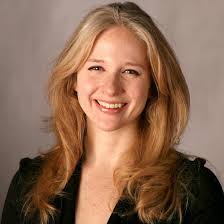
Leila Atassi
Co-sponsored by the Case Western Reserve University Siegal Lifelong Learning Program, League of Women Voters-Greater Cleveland, Cleveland.com and Plain Dealer
Corporate sponsor: First Interstate Properties, Ltd.
For more information, email: teachingcleveland@earthlink.net

“Shaker Square: Its past, present and future”
Tuesday July 25, 2017 7:00-8:30p.m.
Moderated by Steven Litt, Plain Dealer
Cost: Free & Open to the Public
Shaker Public Library Main Branch, 16500 Van Aken Blvd 44120
Shaker Library Notice Event flyer here Forum Preview Here
Summary of forum from Cleveland Scene
Forum Video is here
Panelists:
Brandon E. Chrostowski, Founder, Edwins Leadership & Restaurant Inst.
Peter Rubin, President, The Coral Company
Edward W. Rybka, Chief of Regional Development, City of Cleveland
Captain John Sotomayor, Cleveland Police Fourth District
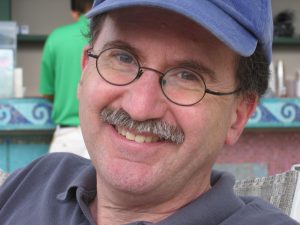
Steven Litt (photo by Lizzie Litt)


How metro Cleveland and Akron stack up against Buffalo, Cincinnati, Columbus, Detroit and Pittsburgh
9/15/2017 Cleveland.com
by Rich Exner
The link is here
“Cleveland” a 1961 magazine about the city’s history
Published by the Plain Dealer
The pdf is here (17mg pdf)
The story of Westlake from the Plain Dealer
“The Drama of Four Key Elections in Cleveland” lecture by James F. Richardson-1984 (video)
The link is here
Cleveland Politics
The Drama of Four Key Elections : 1907, 1915, 1921, and 1929
By James F. Richardson (1984)
Part of “Cleveland Heritage” series